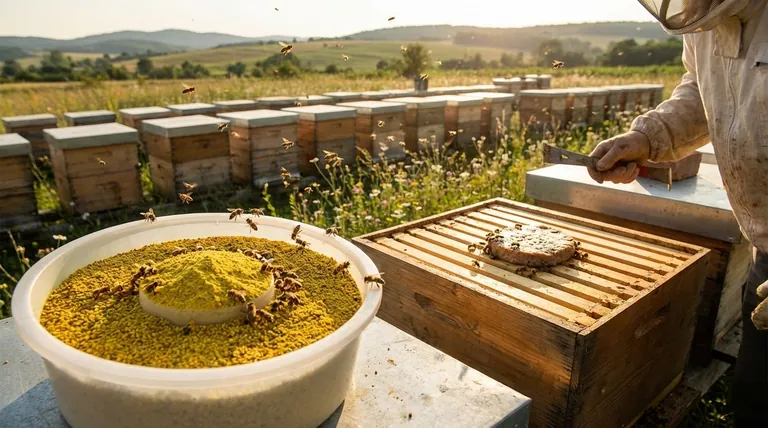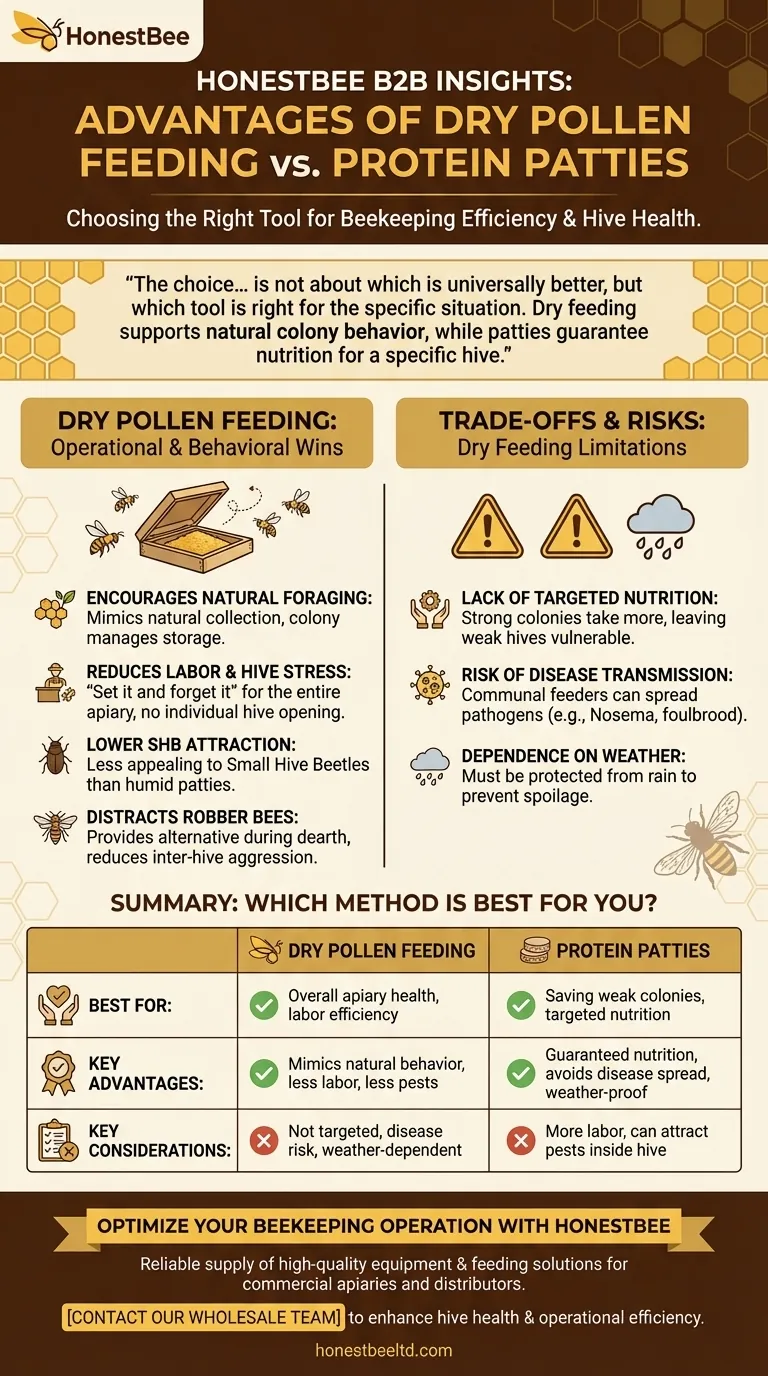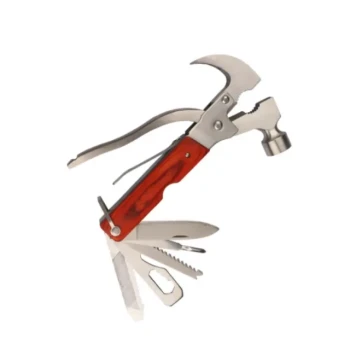In beekeeping, dry pollen feeding offers distinct advantages over protein patties by more closely mimicking natural foraging behavior, reducing beekeeper labor, and minimizing certain pest issues. It allows bees to collect and store protein on their own terms, which can be particularly beneficial for distracting aggressive foragers and managing hive dynamics without constant intervention.
The choice between dry pollen and protein patties is not about which is universally better, but which tool is right for the specific situation. Dry feeding is a broadcast method that supports natural colony behavior, while patties are a targeted intervention to guarantee nutrition for a specific hive.

The Operational and Behavioral Advantages
Dry pollen feeding leverages the bees' natural instincts, which provides several benefits for both the colony and the beekeeper.
Encouraging Natural Foraging
Bees are hardwired to forage. A dry feeder allows them to engage in the natural behavior of collecting pollen, packing it into their pollen baskets, and flying it back to the hive.
This process lets the colony decide how much pollen it needs and where to store it, just as it would with natural pollen sources.
Reducing Beekeeper Labor and Hive Stress
Preparing and placing protein patties requires opening every single hive, which disturbs the colony and takes considerable time.
A dry feeder is a "set it and forget it" solution. You can fill a large feeder and simply replenish it as needed, servicing the entire apiary with one action and without disrupting any colonies.
Pest Management and Apiary Health
How you feed can directly impact the prevalence of pests and the potential for disease transfer within your apiary.
Lower Attraction for Small Hive Beetles
Protein patties inside a warm, humid hive are a prime breeding ground for the small hive beetle (SHB). Larvae can quickly overwhelm a patty and create a significant problem.
Dry pollen substitute, placed in an open-air feeder away from the hives, is far less attractive to SHB and does not provide the ideal environment for their reproduction.
A Distraction for Robber Bees
During a nectar dearth, stronger colonies may attempt to "rob" weaker ones of their resources. A communal dry pollen feeder can redirect the energy of these aggressive foragers.
By providing an easy, alternative food source, you can reduce the pressure on weaker hives and lower the incidence of robbing behavior across the apiary.
Understanding the Trade-offs and Risks
Despite its advantages, dry feeding is not a universal solution. Protein patties remain a critical tool precisely because they solve the problems that dry feeding creates.
Lack of Targeted Nutrition
The greatest weakness of dry feeding is its lack of precision. Strong, dominant colonies will likely gather the most pollen, potentially leaving weaker hives with little to none.
Patties guarantee that a specific colony—especially a weak one that needs building up—receives the protein you intend for it.
Risk of Disease Transmission
A communal feeder is a point of contact for bees from every colony in the area. If one colony has a disease, such as nosema or foulbrood, the feeder can become a vector for spreading the pathogen throughout your entire apiary.
Placing patties within individual hives completely avoids this risk of cross-colony contamination.
Dependence on Weather
Dry pollen feeders must be completely protected from rain and moisture. If the pollen substitute gets wet, it will spoil and become useless. Patties, protected inside the hive, are unaffected by weather.
Making the Right Choice for Your Goal
Your feeding strategy should be a deliberate choice based on the health of your colonies and your management objectives.
- If your primary focus is overall apiary supplementation and labor efficiency: Dry pollen feeding is an excellent way to provide protein with minimal effort and less disruption to the bees.
- If your primary focus is saving a weak colony or boosting a new one: A protein patty is the superior tool to ensure that specific hive gets the nutrition it desperately needs.
- If your primary focus is biosecurity and disease prevention: Avoid communal dry feeders and use patties to maintain strict separation between your colonies.
Ultimately, understanding both methods allows you to apply the right solution at the right time for healthier, more productive bees.
Summary Table:
| Method | Best For | Key Advantages | Key Considerations |
|---|---|---|---|
| Dry Pollen Feeding | Overall apiary health, labor efficiency | Mimics natural behavior, reduces hive stress, less attractive to small hive beetles | Not targeted, risk of disease transmission, weather-dependent |
| Protein Patties | Saving weak colonies, targeted nutrition | Guaranteed nutrition for specific hives, avoids disease spread, weather-proof | More labor-intensive, can attract pests inside the hive |
Optimize Your Beekeeping Operation with the Right Tools
Whether your commercial apiary or distribution business benefits most from efficient dry feeding or targeted patties, having a reliable supply of high-quality beekeeping supplies is crucial. HONESTBEE provides the essential equipment and feeding solutions that commercial apiaries and distributors trust.
Let us help you enhance hive health and operational efficiency. Contact our wholesale team today to discuss your specific needs and explore our product catalog.
Visual Guide

Related Products
- Rapid Bee Feeder White Plastic 2L Round Top Feeder for 8 or 10-Frame Bee Hives
- In-Hive Dual Compartment Frame Bee Feeder for Targeted Colony Nutrition
- HONESTBEE Entrance Bee Feeder Efficient Hive Front Liquid Feeding Solution for Beekeeping
- Boardman Entrance Bee Feeder Durable Galvanized Steel and Wood Construction for Beekeeping
- HONESTBEE Professional Entrance Bee Feeder Hive Nutrition Solution
People Also Ask
- How much honey does a strong hive need to survive winter? Ensure Your Colony's Survival (60-80 lbs)
- Do beekeepers leave honey for bees? The Essential Guide to Sustainable Hive Management
- What is the advice regarding feeding bees to limit brood production based on? Managing Prolific Bee Strains
- Can sugar syrup contaminate the honey crop? A Beekeeper's Guide to Protecting Honey Purity
- What is the best thing to feed bees? A Guide to Supplemental Feeding for a Thriving Hive



















